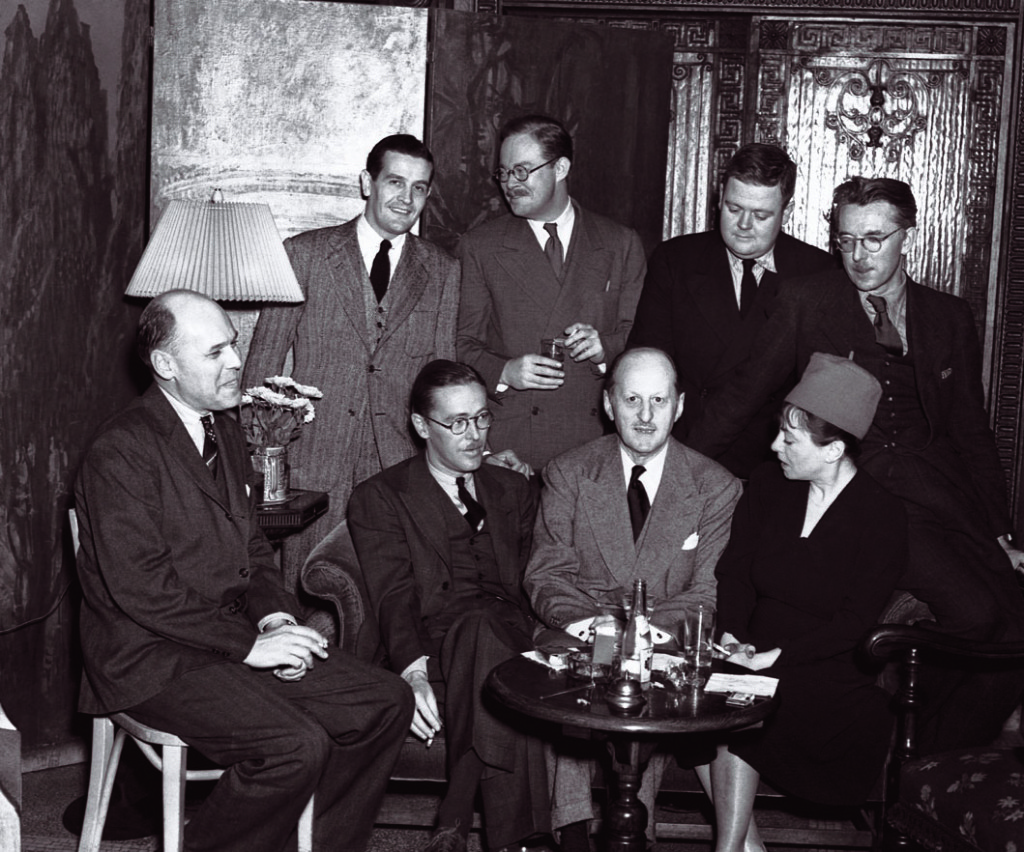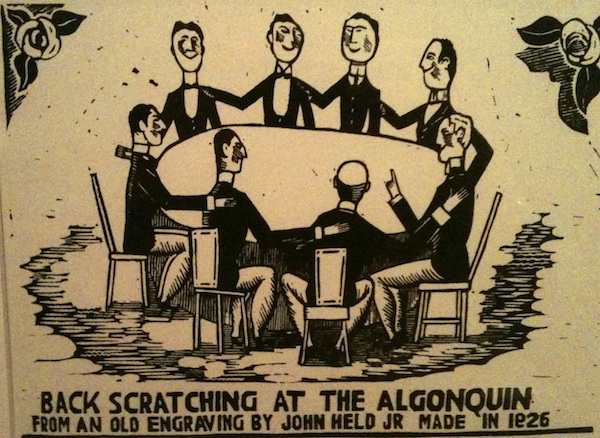A circle of young, exuberant wits, Robert Sherwood among the, regaled Dry-Era America from around a hotel table. Nothing quite like them has been seen since…
When Harding entered the postwar ( WWI) White House and Prohibition dried up the land, boatloads of disaffected intellectuals began taking off to ride out abroad what they regarded as an American cultural dark age. Yet enough of the youngest stayed at home to enliven it and each other. One of the eminences was a young Robert Sherwood, entering New York fresh from battle in Canadian uniform to seek a fledging editorial post and to find himself amid an array of talents as original as his own. …

—While writing theater crticism for Vanity Fair, Parker, Robert Benchley and Robert E. Sherwood begin a series of luncheon salons at the nearby Algonquin Hotel.
A 1938 book party at the Algonquin Hotel: seated, left to right, Fritz Foord, Wolcott Gibbs, Frank Case and Dorothy Parker; standing, Alan Campbell,
St. Clair McKelway, Russell Maloney and James Thurber.—click image for source…
On May 21, 1919, Robert Benchley, two days after he had taken over as managing editor of Vanity Fair, was writing in his diary about “meeting Bob Sherwood who presented his six feet five or ten in candidacy for a job he may get, as Miss Bristed is leaving.” The postscript, as expected, is that Sherwood got the job and a week later was working at the office on a three-month trial basis at twenty-five dollars a week.
The pay was bread but not butter, the door thrown open were large and wide, and the fun, for the eight months that it lasted, was larger still. “No young writer ever had such luck in starting his professional career in such fast company,” Sherwood wrote years later to the author and actress Ilka Chase. Vanity Fair was the Gideon of the sophisticated. Frank Crowninshield was its boutonniere of an editor; Conde Nast, owner of the far more profitable but equally glossy Vogue, was its ducal and frugal publisher; and Sherwood’s two associates, in whose office he was given a desk, were Robert Benchley and Dorothy Parker, with whom he at once formed an inseparable trio. The year was at the spring for Sherwood, and the lark on the wing, even if morning was seldom at seven. He was walking into the twenties under the most smiling and knowing of auspices.

—For literary types, the lunch venue of choice was the Algonquin Hotel on West 44th Street. What would later come to be known as the Algonquin Round Table (or, as its members preferred, “The Vicious Circle,”) began in June of 1919, when Vanity Fair writers Dorothy Parker, Robert Benchley, and Robert E. Sherwood joined like-minded pals for a midday soiree to welcome back famously sharp-penned New York Times drama critic Alexander Wollcott from a stint as a World War I correspondent overseas. Theater agent John Peter Toohey had organized the lunch as a practical joke, ostensibly as a welcome home, but instead used the opportunity to roast Wollcott for failing to include one of his clients in a column—click image for source…
Sherwood had impressed Crowninshield, and the office of Vanity Fair before Benchley was working there, by turning up as a job seeker replendently attired in his kilted Black Watch uniform. Some may have thought that his doing this was poor taste; Sherwood thought it was good sense. Today’s heroes become tomorrow’s bores all too quickly. But when a war is just over, uniforms at that time could open doors, and hearts and Crowninshield was predictably responsive. He knew the Sherwoods and knew of Robert from his work on the HArvard Lampoon, particularly the successful burlesque issue of Vanity Fair, which had appeared under Sherwood’s editorship on April 6, 1917, of all days, the day America declared war on Germany. ( to be continued)…
ADDENDUM:
(see link at end)…Robert Sherwood, reviewing cowboy hero Tom Mix: “They say he rides as if he’s part of the horse, but they don’t say which part.”
Dorothy
ker: “That woman speaks eighteen languages and can’t say ‘no’ in any of them.”George S. Kaufman: Once when asked by a press agent, “How do I get my leading lady’s name into your newspaper?” Kaufman replied, “Shoot her.”
The period that followed the end of World War I was one of gaiety and optimism, and it sparked a new era of creativity in American culture. Surely one of the most profound — and outrageous — influences on the times was the group of a dozen or so tastemakers who lunched together at New York City’s Algonquin Hotel. For more than a decade they met daily and came to be known as the Algonquin Round Table. With members such as writers Dorothy Parker, Harold Ross (founder of THE NEW YORKER) and Robert Benchley; columnists Franklin Pierce Adams and Heywood Broun, and Broun’s wife Ruth Hale; critic Alexander Woollcott; comedian Harpo Marx; and playwrights George S. Kaufman, Marc Connelly, Edna Ferber, and Robert Sherwood, the Round Table embodied an era and changed forever the face of American humor.
It all began with an afternoon roast of the NEW YORK TIMES drama critic, Alexander Wollcott. A number of writers met up at the Algonquin Hotel on 44th street and had such a good time that the event was repeated the next day, and the day after that, until the lunch table at the Algonquin was established as a ritual. The core group of friends was sometimes joined by others who attended for short periods or drifted about the periphery of the group, including such notables as actress Tallulah Bankhead and playwright Noel Coward. The Round Table was made up of people with a shared admiration for each other’s work. Outspoken and outrageous, they would often quote each other freely in their daily columns.Read More:http://www.pbs.org/wnet/americanmasters/episodes/the-algonquin-round-table/about-the-algonquin/527/





 COMMENTS
COMMENTS